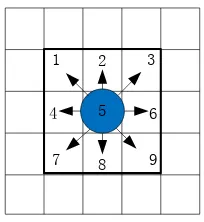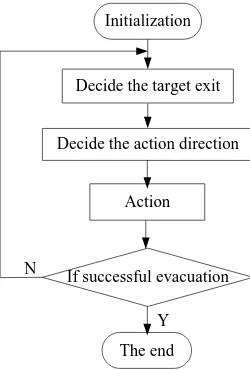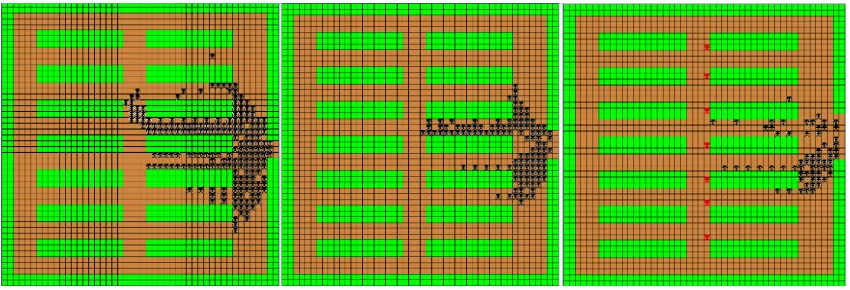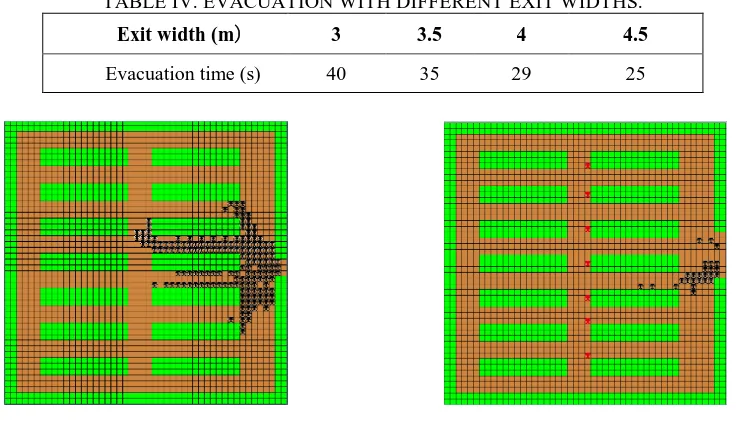2019 International Conference on Computer Intelligent Systems and Network Remote Control (CISNRC 2019) ISBN: 978-1-60595-651-0
Research on Personnel Emergency Evacuation
Model Based on Multi-agent
Jicheng Zhang and Wenjie Shen
ABSTRACT
As it is impossible to simulate the whole process of evacuation in case of emergencies, based on the analysis and comparison of existing evacuation simulation models, considering the intelligence, interaction and autonomy of agents, multi-agent technology is introduced to model the emergency evacuation model. In this model, the evacuation space is divided into equal squares. In the decision-making process of selecting the evacuation exit, the distance from the individual to the exit, the number of people in the field of vision, the number of obstacles and the relevant density are comprehensively considered. No guide, fixed instructions and guidance for the three cases of evacuation process simulation, in the simulation, considering the number of the position and exit, simulation results showed that increasing the exit quantity and the width , In the process of evacuation, guides are added to make real-time direction guidance for agents, which can greatly improve the efficiency of evacuation. The research has very important reference significance for formulating scientific and reasonable emergency evacuation plan and reducing various losses caused by disasters.
KEYWORDS
Multi-agent, Pedestrian Evacuation, Evacuation Efficiency, Simulation, Model Modeling.
INTRODUCTION
In recent years, with the increasing expansion of cities scale, large scale public places have large population and high concentration of people. In such as fire emergency evacuation, if people cannot be scientifically and effectively organized for emergency evacuation, serious loss of life and property will be caused once the disaster has happened. It is expensive to conduct real experiments on emergencies, and most scholars study evacuation model based on Agent simulation modeling. From the point of view of the current research, the macroscopic model in the simulation model considers the simulated object as a whole and ignores the differences among individuals. While the microscopic model considers the heterogeneity of groups, literature[1]proposes a universal Agent evacuation simulation _______________________________________
Jicheng Zhang, Yangtze University College of Technology & Engineering, Jingzhou 434020 China
model, and literature[2-8]studies the application of multi-agent in large-scale public places such as gym, subway and mine evacuation. In this paper, through the establishment of a micro-simulation model of the disaster area, the study of various characteristics of emergency personnel, the introduction of multi-agent technology, the evacuation process of personnel in various circumstances simulation, the results show that increasing the number of exits and the width of the exit, the evacuation process with the guide can effectively improve the efficiency of evacuation. The research has very important reference significance for formulating scientific and reasonable emergency evacuation plan and reducing various losses caused by disasters.
AGENT MODEL OF PERSONNEL EVACUATION
The Agent Profile
Agent is an intelligent entity with automated behavior ability, it is typical of the autonomy, cooperation and learning ability. Besides, It can decide and control its own behavior according to its own state and external environment, and can cooperate with other agents to jointly complete the general goal of the system. Agent has the following characteristics: first, it is reactive, able to perceive changes in the external environment through various interfaces and communication mechanisms, and make appropriate responses to the environment in time. The second is autonomy. It can operate autonomously under the direct intervention of no one or other systems, and can control the internal state and its own behavior according to its internal state and perceived environmental information. Thirdly, it is social. Through some Agent communication language, it can interact with other agents flexibly and carry out effective cooperation. Fourth, intelligence. Agents have the analytical ability to take actions according to goals, and can improve according to experience and learning. The knowledge and resources of a single Agent are limited, so the concept of multi-agent is proposed.
The Model Basis Based on Agent
ENVIRONMENT HYPOTHESIS AND AGENT PROPERTY DESCRIPTION OF PERSONNEL EVACUATION
boundary, obstacle, evacuation exit, evacuee, etc., or is empty. When restricted by boundaries and obstructions, one cannot enter or cross these areas. Microscopic evacuation simulation model based on multi-agent technology modeling pay more attention to the individual, the individual's internal characteristics due to the space position, body health and bigger difference among different individual attributes, therefore individual model definition will be different, this article defines each evacuated staff as an Agent, its property set Person is
Person={Pid,X,Y, X,Y, Eexit,Epath,}, where Pid is the marker of the individual, coordinate (X,Y) is the grid coordinate of the individual, (X,Y) is the physical coordinate of the individual,Eexit is the target evacuation exit currently selected by the individual, and Epath is the next moving direction.
INDIVIDUAL AGENT BEHAVIOR MODELING
The key of individual Agent behavior modeling lies in how to choose evacuation exit and action direction. This paper represents that each individual has 9 next action directions with a certain probability, as shown in Figure 1.
5 2
6 3
[image:3.612.255.357.326.437.2]9 8 7 4 1
Figure 1. The feasible direction of the individual.
Considering the area where an individual can only obtain local information, this paper sets the visible area of an individual as the 24 grids around it, and the individual selects the evacuation exit after considering various factors comprehensively, so as to select the next moving direction. The basic rules of the Agent behavior of the evacuated personnel are as follows.
(1)In the case of spontaneous evacuation, the Agent can choose the direction to escape from obstacles in the visible area.
(2)According to the state of the Agent at time t and the properties of other grids in its neighborhood, the Agent selects the optimal grid that can be reached as the target grid at time t+1.
(3)When multiple agents choose the same grid as the target grid at time t+1, their competitiveness needs to be compared. In the end, the Agent with the most competitive ability will smoothly enter its target grid, while the other agents choose the sub-optimal grid in their respective neighborhood as the moving target.
MULTI-AGENT BASED EVACUATION MODEL MODELING
Individual Evacuation Model Framework
In the process of individual evacuation mode, the action rules of an individual are affected by multiple factors, such as the position of an individual, the ability of an individual, the location of the exit, the density of the Agent, obstacles in the field of vision and so on. Studies show that pedestrians do not always move towards the nearest exit. Considering evacuation rules, the framework of individual evacuation model adopted in this paper is shown in Figure 2.
Initialization
If successful evacuation Decide the target exit
Decide the action direction
Action
The end N
[image:4.612.243.368.229.414.2]Y
Figure 2. Individual evacuation model framework.
Model Modeling and Algorithm Description
According to the individual evacuation model framework in figure 2, the multi-agent evacuation algorithm is as follows.
1) Decide the target exit.
If there are multiple feasible exits, each Agent needs to first determine the target exit before determining the next action party. This process is affected by the exit distance, the number of evacuees in the Agent's field of vision and the number and density of obstacles.
(1) Calculate the distance to the exit.
Suppose there are N exits in the evacuation zone, each exit occupies N grid width, then the distance from the individual to each small grid
j i
D is
2 2
) ( )
( j j
j
i d i
d
i x x y y
D (1)
j i
U is defined as the grid set from the individual to the j-th grid field of vision area at the i-th exit, then the sum of the number of people and the number of obstacles j i S is ,' ' ( ', ') y x g S j i j U y x i
(2)
The coordinate (x',y')occupied by an individual or obstacle g(x',y')is 1, otherwise 0.
(3) Calculate personnel density and obstacle density to the exit.
j i
U is defined as the number of grids in the field of vision area from the individual to the j-th grid at the i-th exit, then the density of people and obstacles
j i
M is
j j j i i i U S
M (3)
(4) Comprehensive determination of exit.
To determine the individual target outlet, comprehensive factors such as the exit distance, the number of obstacles to the exit and its density should be taken into account. The target exit
* * j i C is 3 2 1 3 2 1 1 , 1 * min arg * j j j j i i i n j N i M S D
i (4)
Among them, the influence weights of the above three factors on individual decision-making are respectively expressed by1,2,3.
2) Decide the action direction.
With individuals as the center, 9 feasible directions j can be selected by individuals, as shown in figure 1. The distance to the target exit j
T
D is the same as formula (1).The sum of the number of people and obstacles in the visual field to the target exit j
T
1 2 3
3 2 1 9 1min arg j T j T j T j j o M S D
V (5)
3 2 1 3 2 1 , 9 1 min arg j T j T j T V j j j so M S D V O (6) 3) Action.
In this model, the moving process of individuals toward the target exit is the action process. The moving order of individuals comprehensively considers the distance and individual ability. If these two indexes are the same, the moving order is determined randomly.
SIMULATION OF EVACUATION MODEL
Simulation Software Design
The main function of this simulation software is to simulate the evacuation of people in public places. In the design process, the agent-based modeling method is used, which consists of two layers: presentation layer and execution layer. The presentation layer is realized through the interface Agent, which is responsible for presenting other agents to users in a more intuitive way. The executive layer includes: the guide Agent, who is responsible for the evacuation of people in the place, the young and middle-aged Agent and the old and weak Agent, who are the people in the public places that need to evacuate, and the obstacle Agent, which is the object that will hinder the evacuation process in the evacuation place.
The Simulation Process
The agent-based modeling method is used to simulate the application on Repast platform. The simulation in this paper is a supermarket of 24m*25m. The initial state properties of the evacuated agents distributed in the supermarket are all given randomly. Among them, the young and middle-aged Agent is represented by black color and the guide Agent is represented by red. Moreover, the initial number of agents, the exit width of supermarkets and the exit quantity can be set each time.
Simulation of Evacuation Process Under Different Circumstances
Evacuation of personnel can be divided into three situations: no guidance, guidance with fixed instruction information and guidance with on-site guide.
(1) Situation 1: evacuation without guidance.
In this case, the Agent can receive the information from the sign marked with the direction indication of the safety exit, and select the path under the guidance of this information. The total length of all evacuees travelling is 6811 meters, and the time of complete evacuation is 48s.
(3) Situation 3: evacuation of personnel with guidance.
In this case, since the field guide has mastered the personnel distribution on each channel from a macroscopic perspective, the Agent evacuates along the provided path under the guidance of the field guide. The total length of all evacuees travelling is 5534 meters, and the time of complete evacuation is 38.5s.
The statistical comparison of evacuation in the three cases is shown in Table I.
TABLE I. VARIATIONTABLE OF THE REMAINING NUMBER OF PEOPLE IN EVACUATION SITES WITH TIME UNDER DIFFERENT CIRCUMSTANCES.
Evacuation time 0s 10s 20s 30s 40s 50s 60s
[image:7.612.90.515.351.496.2]The remainder of situation one 300 267 219 166 122 78 35 The remainder of situation two 300 250 173 92 23 0 0 The remainder of situation three 300 227 120 26 0 0 0
Figure 3 shows the distribution of evacuation in three cases after 25s.
(a)No guida (b) Under the guidance of fixed information (c)Under the guidance of the guide Figure 3. Distribution map of evacuation in the three cases after 25s.
Simulation of Evacuation Process with Different Parameters in the Same Situation
(1) evacuation conditions of different Numbers of evacuees.
[image:7.612.112.483.685.723.2]The initial conditions are: the width of the exit is 3 meters, and the number of exits is one. The evacuation situation of evacuees with different Numbers is shown in Table II.
TABLE II. DIFFERENT NUMBERS OF EVACUEES EVACUATION SITUATION.
Number of evacuees (persons) 100 200 300 400
(2) evacuation of different exits.
The initial conditions are: the initial number of people is 300, and the exit width is 3 meters. The evacuation conditions of different exits are shown in Table III.
TABLE III. EVACUATION SITUATION OF DIFFERENT NUMBER OF EXITS.
Evacuation exit (number) 1 2 3 4
Evacuation time (s) 40 24 15 11
(3) evacuation situations with different exit widths.
[image:8.612.111.479.309.522.2]The initial conditions are as follows: initial number of 300 people, one exit, evacuation conditions with different exit widths are shown in Table IV, evacuation diagram for 30s is shown in Figure 4.
TABLE IV. EVACUATION WITH DIFFERENT EXIT WIDTHS.
Exit width (m) 3 3.5 4 4.5
Evacuation time (s) 40 35 29 25
(a) the exit width of 1.5 meters (b) the exit width of 3.5 meters Figure 4. Evacuation distribution map of different exit widths after 30s.
Through the simulation results of the established evacuation model on Repast platform, the following conclusions can be drawn.
(1) From the perspective of guiding evacuation, guiding information greatly accelerates the speed of personnel evacuation. In the case of no guidance information, agents will try many invalid or redundant paths in the process of finding the exit. This behavior set of all agents is bound to increase the chaos of evacuation environment and bring more difficulties for timely evacuation of personnel. Therefore, guidance information is essential for the smooth evacuation of personnel.
to the safety exit. However, in some cases, due to the inertia of thinking or other reasons, many agents choose the same path in multiple paths, so the crowded people on one path may lead to slow evacuation. From the simulation results, it can be seen that by adding guides in evacuation places and using the dynamic information of personnel distribution on each path obtained by guides, the direction guidance of agents can be made in real time, which can make up for the deficiency of fixed information guidance to a large extent.
(3) From the perspective of evacuation exit design, the location of evacuation exit has a great impact on the timely evacuation of personnel. According to the simulation results, in the case of a large number of people, a large number of people will gather and stop near the exit of a single exit, which may cause pushing and trampling and other consequences, causing personal injury. This is the first thing to be avoided in an evacuation. In the case of multiple exits, the distribution of evacuation exits should be scattered in all main directions of the site as far as possible, and the number of exits can be appropriately increased in the direction where people may gather densely. The exit width should not be too narrow, and can be appropriately widened according to the building layout, so as to improve the efficiency of personnel evacuation.
(4) The distribution of guides should be as far as possible in places where paths cross and where people are likely to gather in large Numbers, so as to effectively complete the communication of guiding information and help evacuees reach the safety exit as soon as possible.
SUMMARY
The safe evacuation of personnel is scientific evacuation. This paper introduces the method of multi-agent simulation to study the comparison of evacuation simulation of people flow under emergencies with manual evacuation, with evacuation tips and without evacuation tips, and studies the simulation of individual characteristics of different strengths and weaknesses. According to the simulation results, it can be found that the correct and reasonable way of evacuation can improve the evacuation efficiency, but in the absence of guidance, not only the evacuation efficiency is greatly reduced, but the evacuation time is extended. The location of evacuation exits has a great impact on whether people can evacuate in time. Appropriately increasing the number and width of evacuation exits can reduce evacuation time. It is very important to add guides in evacuation places. Due to the dynamic, complexity and uncertainty of the environment under emergency conditions, as well as individual characteristics of different strengths and weaknesses, the traditional static mathematical model and simulation technology for emergency response simulation have limitations in solving the micro-environment analysis based on individual behavior. It is this that makes the model based on Agent idea more able to reflect the actual dynamic changing environment and solve practical problems.
strategy more reasonable. Although the current crowd evacuation simulation system still has obvious shortcomings, with the increasing ability of the model and corresponding simulation software, it is believed that they will be more and more widely used in the practical work of crowd evacuation.
ACKNOWLEDGMENTS
This work was financially supported by Science and technology research project of Hubei department of education (B2019364) fund.
REFERENCES
1. Li Hui, Wang Hanning, Zeng Wencong, et al. Research on micro-agent simulation model of evacuation under direction of macro-scene[J].Application Research of Computers, 2011, 28(11):4111-4114.
2. Cao Aichun, Yang Xiaoting, Hou Xudong. Crowd evacuation model for large sports venues based on multi-Agent and Cellular Automata technology[J]. Computer Engineering and Applications, 2013, 49(24):229-232.
3. Chen Yingxin .Study on interaction of crowd emergency evacuation in subway station based on multi-agent[J].Computer Applications and Software, 2013, 30(10):226-228+325.
4. Lu Na, Liu Dongmei, Yao Tianlin. An evacuation simulation of underground mine fire based on the agent decision-making behavior model[J].Fire Science and Technology, 2016, 35(10):1376-1381.
5. Mei Ling Chu, Paolo Parigi, Jean-Claude Latombe, et al. Simulating effects of signage, groups, and crowds on emergent evacuation patterns[J].AI & Society, 2015, 30(4):493-507.
6. FrantiSek Capkovic.Agent-based modelling of the evacuation of endangered areas in crisis situations[J].Vietnam Journal of Computer Science, 2015, 2(1):35-45.
7. Muzhou Xiong, Shanyu Tang, Dan Zhao. A Hybrid Model for Simulating Crowd Evacuation[J].New Generation Computing, 2013, 31(3):211-235.



